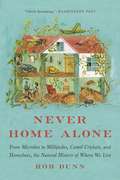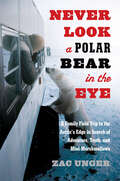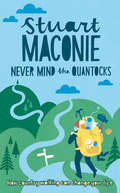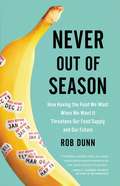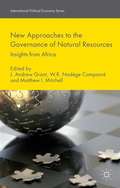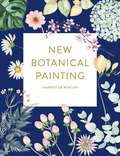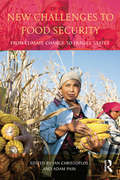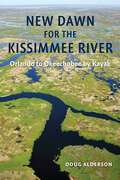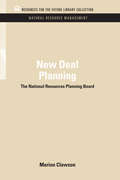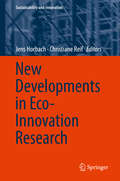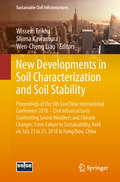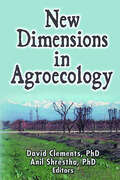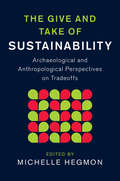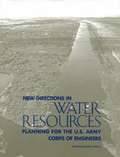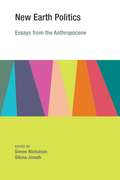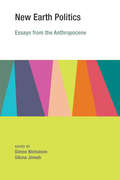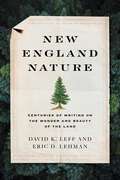- Table View
- List View
Never Cry Wolf: Penguin Modern Classics Edition (Hrw Library)
by Farley MowatThe bestselling nature classic that stands as a hallmark of conservation writing and forever changed the way we look at wolves In 1948, Farley Mowat landed in the far north of Manitoba, Canada, a young biologist sent to investigate the region's dwindling population of caribou. Many people thought that the caribous' conspicuous decline had been caused by the tundra's most notorious predator: the wolf. Alone among the howling canine packs, Mowat expected to find the bloodthirsty beasts of popular conception. Instead, over the course of a summer spent observing the powerful animals, Mowat discovered an animal species with a remarkable capacity for loyalty, virtue, and playfulness. Praised for its humor and engrossing narrative, Never Cry Wolf describes a group of wolves whose interactions and behaviors seem strikingly similar to our own. Mowat humanizes these animals that have long been demonized, turning the widespread narrative of the "savage wolf" on its head and inspiring many governments to enact protective legislation for the North's most mysterious creature.
Never Eat Shredded Wheat
by Christopher SomervilleBognor Regis...Aberystwyth...Glasgow...Can you place them on a map? Most people can't these days. What kind of countryside do you pass through on your way to the Cairngorms, or the Fens, or Northumberland? What's north of the Pennines? And what's it like when you get there? Most folk wouldn't have a clue. Increasing numbers of us don't have a basic geographical notion of these islands. Blame it on a decline in formal geography teaching, or Sat-Nav and other 'A to Z and nothing in between' devices that make us lazy -- we are becoming the best travelled and least well orientated Britons ever seen. Now Christopher Somerville, bestselling author of Coast and many other books of UK exploration, presents the basics of what belongs where, which counties border one another, and what lies beyond the Watford Gap. He reminds us of the watery bits, the lumpy bits and the flat bits, and gets to grips with the smaller islands surrounding Britain -- and much more. Never Eat Shredded Wheat is a reminder of all the fascinating British geography once learned at school - geography that brings our islands vividly to life - geography which we have forgotten, or never even knew.
Never Eat Shredded Wheat: The Geography We've Lost And How To Find It Again
by Christopher SomervilleDo you remember using the mnemonic Never Eat Shredded Wheat to remember the compass directions?<P> Bognor Regis...Aberystwyth...Glasgow...Can you place them on a map? Most people can't these days. What kind of countryside do you pass through on your way to the Cairngorms, or the Fens, or Northumberland? What's north of the Pennines? And what's it like when you get there? Most folk wouldn't have a clue. Increasing numbers of us don't have a basic geographical notion of these islands. Blame it on a decline in formal geography teaching, or Sat-Nav and other 'A to Z and nothing in between' devices that make us lazy -- we are becoming the best travelled and least well orientated Britons ever seen. <P> Now Christopher Somerville, bestselling author of Coast and many other books of UK exploration, presents the basics of what belongs where, which counties border one another, and what lies beyond the Watford Gap. He reminds us of the watery bits, the lumpy bits and the flat bits, and gets to grips with the smaller islands surrounding Britain -- and much more. Never Eat Shredded Wheat is a reminder of all the fascinating British geography once learned at school - geography that brings our islands vividly to life - geography which we have forgotten, or never even knew.
Never Home Alone: From Microbes to Millipedes, Camel Crickets, and Honeybees, the Natural History of Where We Live
by Rob DunnA natural history of the wilderness in our homes, from the microbes in our showers to the crickets in our basements <P><P>Even when the floors are sparkling clean and the house seems silent, our domestic domain is wild beyond imagination. In Never Home Alone, biologist Rob Dunn introduces us to the nearly 200,000 species living with us in our own homes, from the Egyptian meal moths in our cupboards and camel crickets in our basements to the lactobacillus lounging on our kitchen counters. You are not alone. <P><P>Yet, as we obsess over sterilizing our homes and separating our spaces from nature, we are unwittingly cultivating an entirely new playground for evolution. These changes are reshaping the organisms that live with us--prompting some to become more dangerous, while undermining those species that benefit our bodies or help us keep more threatening organisms at bay. <P><P>No one who reads this engrossing, revelatory book will look at their homes in the same way again.
Never Look a Polar Bear in the Eye: A Family Field Trip to the Arctic's Edge in Search of Adventure, Truth, and Mini-Marshmallows
by Zac Unger"I like to go out for walks, but it's a little awkward to push the baby stroller and carry a shotgun at the same time."--housewife from Churchill, Manitoba Yes, welcome to Churchill, Manitoba. Year-round human population: 943. Yet despite the isolation and the searing cold here at the arctic's edge, visitors from around the globe flock to the town every fall, driven by a single purpose: to see polar bears in the wild.Churchill is "The Polar Bear Capital of the World," and for one unforgettable "bear season," Zac Unger, his wife, and his three children moved from Oakland, California, to make it their temporary home. But they soon discovered that it's really the polar bears who are at home in Churchill, roaming past the coffee shop on the main drag, peering into garbage cans, languorously scratching their backs against fence posts and front doorways. Where kids in other towns receive admonitions about talking to strangers, Churchill schoolchildren get "Let's All Be Bear Aware" booklets to bring home. (Lesson number 8: Never explore bad-smelling areas.)Zac Unger takes readers on a spirited and often wildly funny journey to a place as unique as it is remote, a place where natives, tourists, scientists, conservationists, and the most ferocious predators on the planet converge. In the process he becomes embroiled in the controversy surrounding "polar bear science"--and finds out that some of what we've been led to believe about the bears' imminent extinction may not be quite the case. But mostly what he learns is about human behavior in extreme situations . . . and also why you should never even think of looking a polar bear in the eye.
Never Mind the Quantocks: How Country Walking Can Change Your Life
by Stuart MaconieIn this hilarious and heart-warming collection of essays, writer and broadcaster Stuart Maconie reflects on a life spent exploring the British countryside on foot. From the splendour of the Pennines and the Lake District to the drama of the Dorset coast; from the canals of the Midlands to wildest Scotland, this book is an attempt to explain a passion for walking and the delights it can bring. Culled from his monthly column in Country Walking magazine, it's full of the beautiful places, magical moments and wonderful characters Stuart has encountered on his travels. It discusses such intrepid adventures as taking on the famous 'Wainwright' fells of the Lake District, walking Hadrian's Wall with colleague Mark Radcliffe, and why the most important things to carry in a rucksack are a transistor radio and a small bottle of red wine.
Never Out of Season: How Having the Food We Want When We Want It Threatens Our Food Supply and Our Future
by Rob DunnA Fast Food Nation for the foods we grow and depend onThe bananas we eat today aren't your parents' bananas: We eat a recognizable, consistent breakfast fruit that was standardized in the 1960s from dozens into one basic banana. But because of that, the banana we love is dangerously susceptible to a pathogen that might wipe them out.That's the story of our food today: Modern science has brought us produce in perpetual abundance-once-rare fruits are seemingly never out of season, and we breed and clone the hardiest, best-tasting varieties of the crops we rely on most. As a result, a smaller proportion of people on earth go hungry today than at any other moment in the last thousand years, and the streamlining of our food supply guarantees that the food we buy, from bananas to coffee to wheat, tastes the same every single time.Our corporate food system has nearly perfected the process of turning sunlight, water and nutrients into food. But our crops themselves remain susceptible to the nature's fury. And nature always wins.Authoritative, urgent, and filled with fascinating heroes and villains from around the world, Never Out of Season is the story of the crops we depend on most and the scientists racing to preserve the diversity of life, in order to save our food supply, and us.
New And Selected Poems: 1962-2012
by Charles Simic&“It takes just one glimpse of Charles Simic&’s work to establish that he is a master, ruler of his own eccentric kingdom of jittery syntax and signature insight.&” -Los Angeles TimesFor over fifty years, Charles Simic has been widely celebrated for his brilliant and innovative poetic imagery, his sardonic wit, and a voice all his own. He has been awarded nearly every major literary prize for his poetry, including a Pulitzer and a MacArthur grant, in addition to serving as the poet laureate of the United States in 2007 and 2008.In this new volume, he distills his life&’s work, combining for the first time the best of his early poems with his later works—including nearly three dozen revisions—along with seventeen new, never-before-published poems. Simic&’s body of work draws inspiration from a range of topics, from the inscrutability of ordinary life to American blues, from folktales to marriage and war.Consistently exciting and unexpected, the nearly four hundred poems in this volume represent the best of one of America&’s most distinguished and original poets.
New Approaches on Energy and the Environment: Policy Advice for the President
by Richard D. Morgenstern Paul R. PortneyWritten by economists and policy analysts at Resources for the Future, a Washington, DC, think tank with a tradition for independent, objective research, this collection of twenty-five 'memos to the President' offers constructive policy options for the elected administration on critical challenges related to energy, the environment, and natural resources. Each contributor to New Approaches on Energy and the Environment was asked to address the question: 'Based on your research and knowledge, what policy recommendation would you like to make to the next U.S. president?' Writing in advance of the 2004 election so as to keep their essays free of partisan interpretations, the authors were asked not to confine their suggestions to what the prevailing wisdom says is politically possible. They also took pains to make their ideas accessible to a busy president as well as a wide range of readers interested in a concise and authoritative overview of the nation's energy and environmental policy choices. The results are provocative, sometimes controversial, but highly readable essays on topics including climate change, oil dependency, electricity regulation, brownfields revitalization, forest service administration, air and water quality, and environmental health issues such as food safety and the growing threat of antibiotic resistance. When the President takes office in January, 2005, he will confront competing perspectives about the priorities and approaches that should apply to energy and environmental policy: Americans want cleaner air and water and healthy and attractive surroundings, but they also want inexpensive fuel, comfortable cars and houses, and continued economic growth. New Approaches on Energy and the Environment provides thought-provoking, commonsense contributions to debates about important energy and environmental issues confronting the U.S. today.
New Approaches to the Governance of Natural Resources
by J. Andrew Grant W.R. Nad�ge Compaor� Matthew I. MitchellThe resurgent economic and geopolitical importance of Africa is evidenced by the growing investment by China, India, the United States, Brazil, and other countries in the continent's various natural resources sectors, such as oil, biofuels, forestry, fisheries, and minerals. This book provides an in-depth analysis of the governance of natural resources in Africa and new insights for readers as they navigate the burgeoning research on global governance initiatives and regional and national strategies. Moreover, by carefully examining both theoretical and policy-related debates (and drawing upon public opinion data in countries such as Angola and South Sudan), the book makes important connections between theory and practice surrounding natural resource sectors. Consequently, it offers scholars, graduate students, policy-makers, think tank researchers, and media with a comprehensive and authoritative examination of the current research being conducted on the governance of natural resources in Africa.
New Botanical Painting
by Harriet de WintonAward-winning artist Harriet de Winton shows you how to create contemporary watercolour artworks to treasure and share. Through more than 30 step-by-step projects, discover how to paint individual flowers and foliage, as well as beautiful botanical compositions. Use your new skills to make art for your wall, unique cards, invitations, or simply paint for pleasure.
New Botanical Painting
by Harriet de WintonAward-winning artist Harriet de Winton shows you how to create contemporary watercolour artworks to treasure and share. Through more than 30 step-by-step projects, discover how to paint individual flowers and foliage, as well as beautiful botanical compositions. Use your new skills to make art for your wall, unique cards, invitations, or simply paint for pleasure.
New Challenges to Food Security: From Climate Change to Fragile States
by Ian Christoplos Adam PainFood security is high on the political agenda. Fears about societal insecurity due to food price increases and hunger, grave scenarios regarding the effects of climate change and general uncertainty about the impacts of investments in biofuels and so-call “land grabbing” on food prices and availability have meant that food security is now recognised as being a multifaceted challenge. This book is unique in that it will bring together analyses of these different factors that impact on food security. This volume will describe a range of different perspectives on food security, with an emphasis on the various meanings that are applied to food security “crisis”. The challenges to be reviewed include market volatility, climate change and state fragility. Analyses of responses to food security crises and risk will cover rural and urban contexts, arenas of national policy formation and global food regimes, and investment in land and productive technologies. This book is unique in two respects. First, it takes a step back from the normative literature focused on specific factors of, for example, climate change, agricultural production or market volatility to look instead at the dynamic interplay between these new challenges. It helps readers to understand that food security is not one discourse, but is rather related to how these different factors generate multiple risks and opportunities. Second, through the case studies the book particularly emphasises how these factors come together at local levels as farmers, entrepreneurs, consumers, local government officials and others are making key decisions about what will be done to address food security and whose food security will be given priority. The book will explore how food production and consumption is embedded in powerful political and market forces and how these influence local actions.
New Dawn for the Kissimmee River: Orlando to Okeechobee by Kayak
by Doug AldersonFirst-Place Winner, Florida Writers Association Royal Palm Literary Award Exploring and chronicling a restored river in the heart of Florida The Kissimmee Valley, which includes the Kissimmee chain of lakes and Kissimmee River, covers an area from Orlando to Lake Okeechobee. The headwaters and grand gateway to the Everglades, the area is the domain of the alligator and bald eagle, snail kite and spoonbill, stretching more than 100 miles through central Florida.Between 1960 and 1971, the Army Corps of Engineers straightened and diverted the river’s flow to control persistent flooding. These alterations shortened the length of the Kissimmee, significantly reduced wildlife populations, and created a lucrative real estate market that further threatened native species. In 1992, Congress acted to restore the river to its original flow.In the spring of 2007, Doug Alderson joined an expedition down the Kissimmee chain of lakes and the newly restored river. The group witnessed firsthand the recovering bird populations, spotted otters, turtles, alligators, and other wildlife that make up the hidden beauty of this part of Florida.In New Dawn for the Kissimmee River, Alderson uses this twelve-day paddling excursion as a thread to explore the history and ecology of the region, while highlighting the most successful restoration project of its kind in the world, the model for the overall Everglades restoration plan.
New Deal Planning: The National Resources Planning Board (RFF Natural Resource Management Set)
by Marion ClawsonFirst Published in 2011. Routledge is an imprint of Taylor & Francis, an informa company.
New Developments in Eco-Innovation Research (Sustainability and Innovation)
by Jens Horbach Christiane ReifEco-innovations are crucial for reducing the environmental damages arising from economic activities, and are one of the main drivers of a successful transition towards sustainable development and remedying essential climate change problems. This book provides an overview of recent advances in the rapidly growing field of eco-innovation research, adopts an interdisciplinary perspective and outlines the main future developmental trends. A broad range of topics are addressed, including a bibliometric analysis of eco-innovation research, the relationship between eco-innovation and corporate sustainability, eco-innovation system analysis, new evidence on the economic effects of eco-innovation, and the relevance of policy and policy mixes for eco-innovation activities. The book is dedicated to Klaus Rennings, one of the most important representatives of this field, who unexpectedly passed away in September 2015.
New Developments in Soil Characterization and Soil Stability: Proceedings of the 5th GeoChina International Conference 2018 – Civil Infrastructures Confronting Severe Weathers and Climate Changes: From Failure to Sustainability, held on July 23 to 25, 2018 in HangZhou, China (Sustainable Civil Infrastructures)
by Wissem Frikha Shima Kawamura Wen-Cheng LiaoThis book presents new studies dealing with the attempts made by the scientists and practitioners to address contemporary issues in geotechnical engineering such as characterization of soil, geomaterials, soil stability and some other geomechanics issues that are becoming quite relevant in today's world. Papers were selected from the 5th GeoChina International Conference on Civil Infrastructures Confronting Severe Weathers and Climate Changes: From Failure to Sustainability, held on July 23-25, 2018 in HangZhou, China.
New Dimensions in Agroecology
by Anil Shrestha David ClementsReduce the environmentally negative aspects of industrial agriculture with an ecologically sound philosophy! New Dimensions in Agroecology explores the latest developments in the emerging science of agroecology, focusing on how these new concepts and cutting-edge tools will help minimize the impact of agriculture on the environment and fos
New Directions in Sustainability and Society: The Give and Take of Sustainability
by Michelle HegmonSustainability strives to meet the needs of the present without compromising the future, but increasingly recognizes the tradeoffs among these many needs. Who benefits? Who bears the burden? How are these difficult decisions made? Are people aware of these hard choices? This timely volume brings the perspectives of ethnography and archaeology to bear on these questions by examining case studies from around the world. Written especially for this volume, the essays by an international team of scholars offer archaeological and ethnographic examples from the southwestern United States, the Maya region of Mexico, Africa, India, and the North Atlantic, among other regions. Collectively, they explore the benefits and consequences of growth and development, the social costs of ecological sustainability, and tensions between food and military security.
New Directions in Water Resources Planning for the U.S. Army Corps of Engineers
by National Research CouncilThe U.S. Army Corps of Engineers has long been one of the federal government's key agencies in planning the uses of the nation's waterways and water resources. Though responsible for a range of water-related programs, the Corps's two traditional programs have been flood damage reduction and navigation enhancement. The water resource needs of the nation, however, have for decades been shifting away from engineered control of watersheds toward restoration of ecosystem services and natural hydrologic variability. In response to these shifting needs, legislation was enacted in 1990 which initiated the Corps's involvement in ecological restoration, which is now on par with the Corps's traditional flood damage reduction and navigation roles.This book provides an analysis of the Corps's efforts in ecological restoration, and provides broader recommendations on how the corps might streamline their planning process. It also assesses the impacts of federal legislation on the Corps planning and projects, and provides recommendations on how relevant federal policies might be altered in order to improve Corps planning. Another important shift affecting the Corps has been federal cost-sharing arrangements (enacted in 1986), mandating greater financial participation in Corps water projects by local co-sponsors. The book describes how this has affected the Corps-sponsor relationship, and comments upon how each group must adjust to new planning and political realities.
New Earth Politics: Essays from the Anthropocene
by Simon Nicholson Sikina JinnahHumanity's collective impact on the Earth is vast. The rate and scale of human-driven environmental destruction is quickly outstripping our political and social capacities for managing it. We are in effect creating an Earth 2.0 on which the human signature is everywhere, a "new earth" in desperate need of humane and insightful guidance. In this volume, prominent scholars and practitioners in the field of global environmental politics consider the ecological and political realities of life on the new earth, and probe the field's deepest and most enduring questions at a time of increasing environmental stress. Arranged in complementary pairs, the essays in this volume include reflections on environmental pedagogy, analysis of new geopolitical realities, reflections on the power of social movements and international institutions, and calls for more compelling narratives to promote environmental action. At the heart of the volume is sustained attention to the role of traditional scholarly activities in a world confronting environmental disaster. Some contributors make the case that it is the scholar's role to provide activists with the necessary knowledge and tools; others argue for more direct engagement and political action. All the contributors confront the overriding question: What is the best use of their individual and combined energies, given the dire environmental reality?ContributorsErik Assadourian, Frank Biermann, Wil Burns, Ken Conca, Peter Dauvergne, Daniel Deudney, Navroz Dubash, Richard Falk, Joyeeta Gupta, Maria Ivanova, Peter Jacques, Sikina Jinnah, Karen T. Litfin, Michael F. Maniates, Elizabeth Mendenhall, Simon Nicholson, Kate O'Neill, Judith Shapiro, Paul Wapner, Oran R. Young
New Earth Politics: Essays from the Anthropocene (Earth System Governance)
by Simon Nicholson Sikina JinnahProminent scholars and practitioners consider the role of global environmental politics in the face of increasing environmental stress.Humanity's collective impact on the Earth is vast. The rate and scale of human-driven environmental destruction is quickly outstripping our political and social capacities for managing it. We are in effect creating an Earth 2.0 on which the human signature is everywhere, a “new earth” in desperate need of humane and insightful guidance. In this volume, prominent scholars and practitioners in the field of global environmental politics consider the ecological and political realities of life on the new earth, and probe the field's deepest and most enduring questions at a time of increasing environmental stress. Arranged in complementary pairs, the essays in this volume include reflections on environmental pedagogy, analysis of new geopolitical realities, reflections on the power of social movements and international institutions, and calls for more compelling narratives to promote environmental action. At the heart of the volume is sustained attention to the role of traditional scholarly activities in a world confronting environmental disaster. Some contributors make the case that it is the scholar's role to provide activists with the necessary knowledge and tools; others argue for more direct engagement and political action. All the contributors confront the overriding question: What is the best use of their individual and combined energies, given the dire environmental reality?ContributorsErik Assadourian, Frank Biermann, Wil Burns, Ken Conca, Peter Dauvergne, Daniel Deudney, Navroz Dubash, Richard Falk, Joyeeta Gupta, Maria Ivanova, Peter Jacques, Sikina Jinnah, Karen T. Litfin, Michael F. Maniates, Elizabeth Mendenhall, Simon Nicholson, Kate O'Neill, Judith Shapiro, Paul Wapner, Oran R. Young
New Engagement Strategies for Energy Justice: Perspectives from the Next Generation (Just Transitions)
by Alicia Phillips Laura KaschnyThis book offers an innovative exploration of energy justice, from concept to action, highlighting its role as a crucial tool for navigating the complexities of a just and sustainable energy transition. The book is timely and as the global energy transition rapidly progresses, it will serve as an essential resource, offering practical guidance to advancing a just and sustainable energy future. The perspectives presented in this book are presented by early career energy justice scholars from around the world, each highlighting and proposing ways to navigate the transition. The discussion focuses on three key themes: the integration and repurposing of energy infrastructures with the use of technology, the need for affordable and accessible energy services, and the promotion of responsible governance through effective policymaking and corporate social responsibility. At the heart of this book is the presentation of the ‘Toolkit to Achieve the Just Transition using the Energy Justice Framework’.
New England Forests Through Time: Insights From The Harvard Forest Dioramas
by David R. Foster John F. O'KeefeOver the past three hundred years New England's landscape has been transformed. The forests were cleared; the land was farmed intensively through the mid-nineteenth century and then was allowed to reforest naturally as agriculture shifted west. Today, in many ways the region is more natural than at any time since the American Revolution. This fascinating natural history is essential background for anyone interested in New England's ecology, wildlife, or landscape. In New England Forests through Time these historical and environmental lessons are told through the world-renowned dioramas in Harvard's Fisher Museum. These remarkable models have introduced New England's landscape to countless visitors and have appeared in many ecology, forestry, and natural history texts. This first book based on the dioramas conveys the phenomenal history of the land, the beauty of the models, and new insights into nature.
New England Nature: Centuries of Writing on the Wonder and Beauty of the Land
by David K. Leff Eric D. LehmanSince its founding four hundred years ago, New England has been a vital source of nature writing. Maybe it&’s the diversity of landscapes huddled so close together or the marriage of nature and culture in a relatively small, six-state region. Maybe it&’s the regenerative powers of the ecosystem in a place of repeated exploitations. Or maybe we have simply been thinking about our relationship with the natural world longer than everyone.If all successive nature writing is a footnote to Henry David Thoreau, then New England has a strong claim to being the birthplace of the genre. But there are, as the sixty entries in this anthology demonstrate, many other regional voices that extol the wonders and beauty of the outdoors, explore local ecology, and call for environmental sustainability. Between these covers, Noah Webster calls for our stewardship of nature and Lydia Sigourney finds sublime pleasure in it. Jonathan Edwards and Helen Keller both find miracles, while Samuel Peters and Mark Twain find humor. Author Nathaniel Hawthorne discovers a place to hide his metaphors, while the enslaved James Mars discovers an actual hiding place.Through it all is the apprehension of a profound and lasting splendor, &“the glory of physical nature,&” as W.E.B. Dubois calls it, something beyond our everyday concerns and yet tied so closely to our daily lives that we cannot escape it. Nature writing cultivates our sense of beauty, inflaming curiosity and the passion to explore. It opens us to deep, primal experiences that enrich life. Anyone wanting to understand our relationship with the world must start here.


